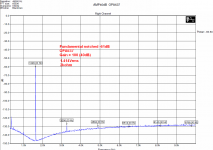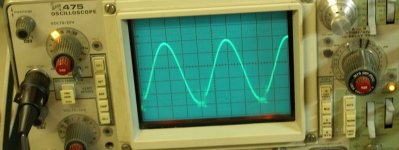Cool, I'm not surprised if it is true.
😀
Right, they are products relying on a unique taste for differentiation. I doubt I could tell two distilled and de-mineralized waters apart even if I put a picture of one in the freezer.
No, it is NOT. That's the point. You are given just 2 choices and told there is a difference. Bad test, proves little to nothing. (Sorry Mooly).That most can pick a difference is fairly clear.
If someone said "I have ESP - I can predict a coin toss!" Then you flipped a coin, he called "Heads!" and was right - would you believe in his ESP? On the single flip?
The X-Y test is even worse.
Re opamp measurement, distortion etc. - please see OPA637 at gain 40dB, 1.414Vrms, 2kohm load
P.S. Feedback resistor is 1kohm.
P.S. Feedback resistor is 1kohm.
Attachments
Last edited:
I would suggest that all those hearing a distinct difference were being truthful. A person extending that, and saying that one sample was the loaded one would then depend on the person's experience of hearing behaviours like that on a regular basis - personally, I heard an immediate difference and didn't aim for anything beyond that.No, it is NOT. That's the point. You are given just 2 choices and told there is a difference. Bad test, proves little to nothing. (Sorry Mooly).
If someone said "I have ESP - I can predict a coin toss!" Then you flipped a coin, he called "Heads!" and was right - would you believe in his ESP? On the single flip?
The X-Y test is even worse.
To decide which is more 'correct' is a way more difficult, and demanding activity ...
But that's not the point, Frank. I don't doubt anyone's listening abilities, just the test.
Add to that the layer of the files being so similar and we should really be skeptical.
Add to that the layer of the files being so similar and we should really be skeptical.
Well, I think Mooly's intent was to say, "OK, everyone is talking about loading ... well, can we hear a difference if that is altered?" Simple as that. The answer is, "Yes", so then we move on ...
Not everybody is born equal
(tetrachromic. Ah, sera toujours les Grecs)
Last edited:
Mooly what's the inhibition, put up two files with a single wire cut in half and connected in both directions in the input as the only difference.
Oscillation can happen to anybody, including fast IC's. That is why we have wide bandwidth oscilloscopes to find them and fix any problem. Now, if we could only get a really good output buffer for some IC op amps. '-)
-140 dB THD at 7V into 50 ohm is no problem at all.
-140 dB THD+N is a slight problem, but it can be done.
BTW: You have to make a complete spec. if you want someone to design such a thing. 🙄
Cheers
S
No problem with more complete spec if you are saying you will do it or try to. But as I said awhile back -- i am just soliciting help for David. If you are going to give it a serious run for fame, glory and a good old fashion challenge for you ... pm me.
______________
It looks like there is a strange reasoning happening here --- because an IC wasnt used as it would be used for a commercial product ...... the sound differences of that distortion generator is invalid? The only question from the distortion creating generator (using 100 Ohms) is what was the detectable distortion level used. Other-wise the test has no useful knowledge value to me.
THx-RNMarsh
Last edited:
Because not only is it 50/50, you can just claim to hear a difference. You don't even have to get ti right. Tho some did, we don't know if it was pure luck.Why is the X-Y test worse?
No, not that simple. He supplied more than half the answer. "The circuits are different and here's how." It is certainly possible that someone really heard a difference and even identified it correctly. But we can not know that from this test. It's a just a game of chance, as far as we know.Well, I think Mooly's intent was to say, "OK, everyone is talking about loading ... well, can we hear a difference if that is altered?" Simple as that. The answer is, "Yes", so then we move on ...
An interesting alternative, which perhaps Mooly is considering, is deliberately loading to the point where distortion is trivially obvious, say 40R. Then do a series of tests where the load is doubled each run, to well past a value that's an issue. Test is then to have people rank them in order.
I like that idea. If he could show the distortion spectrum (or we do it for him) that would be even better.
But Mooly needs to be careful not to give any clues!
But Mooly needs to be careful not to give any clues!
It is not just what happens at full output when considering heavy loading of IC's, because heavy loading stresses the output stage, which in turn creates added crossover distortion, and while it 'may' be hidden by noise, it still can generate FM distortion.
😎🙂 While I have some time to read -- Any suggested info on this?
THx-RNMarsh
I like that idea. If he could show the distortion spectrum (or we do it for him) that would be even better.
But Mooly needs to be careful not to give any clues!
So long as the results are not used as a general wide sweeping finding for all amps or detectable levels etc. A harmonic structure change alone could give different outcome. Odds dominating or even dominating... and harmonic order changes with level, and load, too. Many tests with different amps, levels, loads, FFT's etc will be needed to plot a complete data graph(s) and see if there is a trend which could be a generalization statement.
-RNM
Last edited:
Just sayin' here's one guys Extreme Class A amp
Thankfully mine does not do that.
😉
- Status
- Not open for further replies.
- Home
- Member Areas
- The Lounge
- John Curl's Blowtorch preamplifier part II

